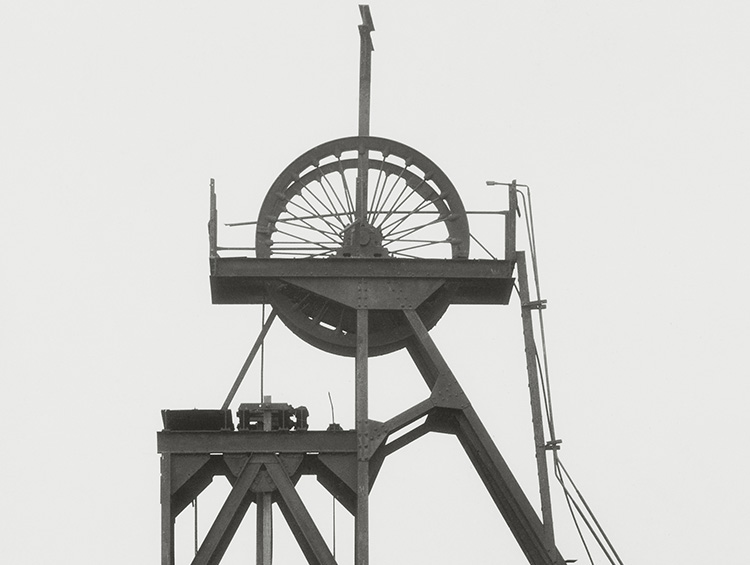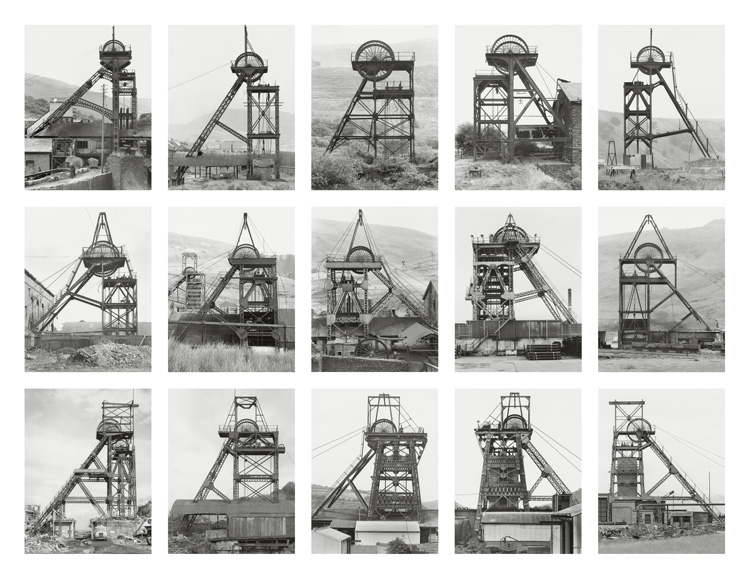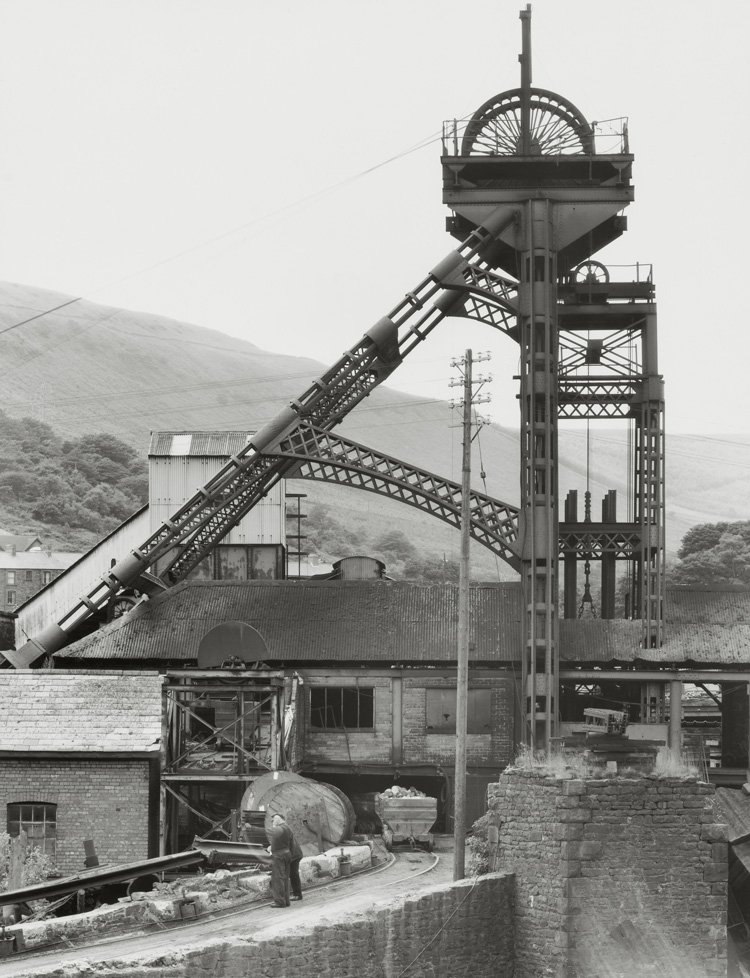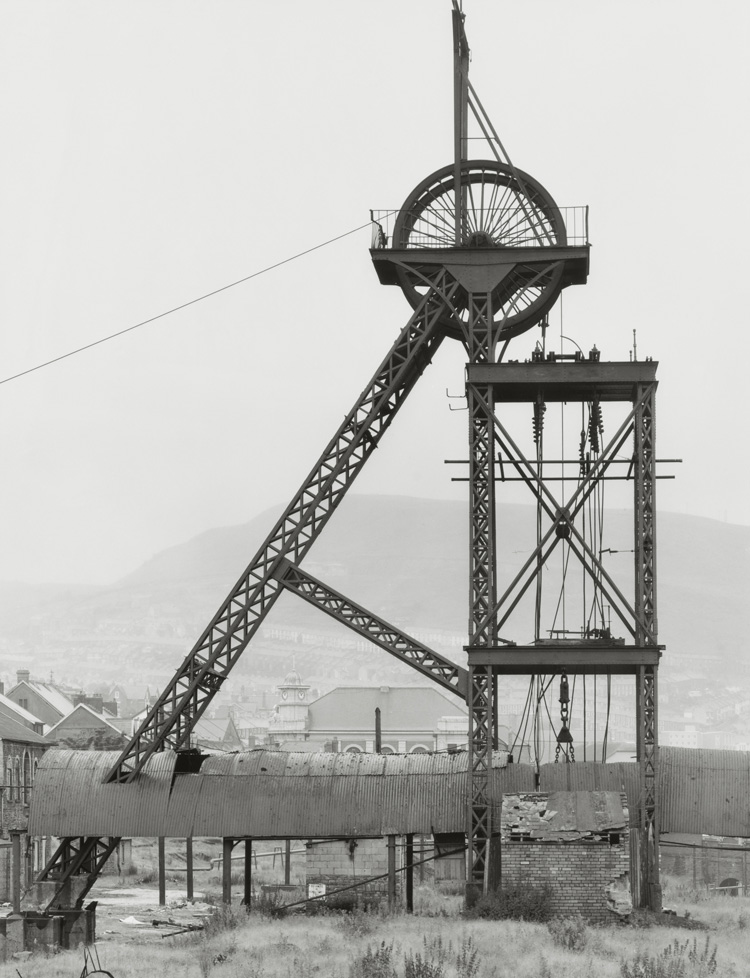
Bernd and Hilla Becher. Blaenserchan Colliery, Pontypool, South Wales, GB, 1966 (detail). © Estate Bernd & Hilla Becher, represented by Max Becher, courtesy Die Photographische Sammlung/SK Stiftung Kultur – Bernd und Hilla Becher Archive, Cologne, 2019.
National Museum Cardiff
26 October 2019 – 1 March 2020
by DAVID TRIGG
In June 1966, the German photographers Bernd and Hilla Becher left their Düsseldorf home and drove, with their young son, Max, to south Wales. With a six-month bursary from the British Council, they travelled from town to village in their VW campervan, diligently recording the waning collieries that were once integral to the economy and culture of the Welsh valleys. Central to the project was the image of the winding tower, the structural frame that stands above mine shafts and is a significant social and cultural icon in the Welsh imagination. Many of those photographs can be seen in this generous 225-work exhibition at the National Museum Cardiff, which draws on the Bechers’ extensive archive of austere black-and-white prints documenting industrial architecture across Britain, Europe and North America, from the mid-60s to the late-90s.

Bernd and Hills Becher. Winding Towers, GB, 1966–1997. © Estate Bernd & Hilla Becher, represented by Max Becher, courtesy Die Photographische Sammlung/SK Stiftung Kultur – Bernd und Hilla Becher Archive, Cologne, 2019.
With coal production on the decline, the winding towers that once littered the Welsh coalfields were already disappearing when the Bechers arrived, just as they were in Germany and other European countries during the postwar era. Bernd (1931-2007) and Hilla (1934-2015) felt compelled to preserve the memory of these and other industrial structures – technologies that, like photography itself, originated in the 19th century. Their stark, impersonal pictures of blast furnaces, water towers, gasometers, cooling towers, grain silos and lime kilns emphasised the formal qualities of the buildings by showing them in isolation. Their approach was methodical and rigorous, using large-format plate cameras in combination with ladders and even scaffolding to achieve optimum viewpoints.
Despite containing more than 200 images, this elegantly curated show does not feel overwhelming. This is due to the Bechers’ trademark grids, where individual photographs of a similar kind, or type, are grouped together in sets of nine, 12, or 15. These groupings, which they called typologies, allow for comparisons to be made between images. They reveal similarities and differences between the depicted structures, often highlighting recurring design elements, such as the geometry of Welsh winding towers or the curious architectural flourishes adorning similar structures at French and Belgian collieries. The Bechers’ use of classificatory principles recalls the monumental series People of the 20th Century, by August Sander (1876-1964), selections from which are displayed in a neighbouring room as part of the museum’s photography season. Beginning in the 1920s, these anonymous portraits identified their German subjects solely by occupation and class. Sander’s project was hugely influential on the Bechers, who likened their own photography to portraiture.

Bernd and Hills Becher. Deep Dyffryn Colliery, Mountain Ash, South Wales, GB, 1966. © Estate Bernd & Hilla Becher, represented by Max Becher, courtesy Die Photographische Sammlung/SK Stiftung Kultur – Bernd und Hilla Becher Archive, Cologne, 2019.
The Bechers referred to the industrial architecture they photographed as “anonymous sculptures”. This anonymity is underscored by the way they composed their images, often isolating industrial structures from their surroundings. It can be jarring, then, when you spot telltale objects, such as a car, a van, or a British road sign in a typology of water towers. Occasionally, the Bechers deliberately provided more context. For example, in Rhondda Valley, South Wales, GB 1966 (1966), a large winding tower is shown soaring above the local town, demonstrating how imposing these structures were for those who lived in their shadows. Considering the economic devastation that pit closures brought to such communities, it is also a haunting image. But the Bechers, whose project was unapologetically formal, deliberately shied away from social commentary, a stance that attracted much criticism.
Neutrality and uniformity were essential to the Bechers’ growing bank of images. They were careful to shoot types of structure from the same angles and heights, and employed diffused lighting to minimise shadows. Their darkroom methodology was similarly rigorous as they sought to align the tonal values of their prints. It was an uncompromising approach that clearly paid off. Witness the remarkable visual consistency in a typology of water towers comprising images ranging from the 60s to the 90s. Nevertheless, the photographers occasionally broke their own rules; stray clouds sometimes appear in the sky and, once in a while, an unusually strong shadow is glimpsed on a structure. Despite the claim that the couple’s work never included people, there are at least two instances here where lone figures appear. Even more surprising is the discovery that one of them is Hilla herself, standing high up, almost invisible, on a vast double headframe. It is in these moments, where rules are transgressed and incidental details go unedited, that the Bechers’ photographs become less dispassionate and somehow more human.

Bernd and Hills Becher. Naval Colliery, Tonypandy, South Wales, GB, 1966. © Estate Bernd & Hilla Becher, represented by Max Becher, courtesy Die Photographische Sammlung/SK Stiftung Kultur – Bernd und Hilla Becher Archive, Cologne, 2019.
In the catalogue for the 1971 Nuremberg Biennale, the Bechers wrote of their work: “Just as cathedrals came out of the medieval world view and castles embody the feudal system, these edifices are to be seen as emanations of our time, as a self-representation of our society.” Yet the Victorian structures they documented barely belonged to their own era. Indeed, many of their subjects in Wales were already on the verge of destruction, photographed at decommissioned sites soon before demolition. This accounts for the air of melancholy that pervades this exhibition; all around are signs of lost heritage and reminders of the communities whose hearts were ripped out by pit closures.
Particularly bleak is a typology of rubbish-strewn colliery buildings in Welsh towns and villages. Photographed in 1966, these dilapidated sites in Cymmer, Blaenrhondda, Bargoed, Ferndale, Caerphilly and Crumlin, among others, recall Paul Strand’s photographs of New Mexico ghost towns in the United States. Despite being worlds apart, both culturally and geographically, the two projects present the remnants of shattered mining communities and, by extension, the lost hopes of a generation. The show’s co-curator, Russell Roberts, notes that the Bechers’ photographs confront us with “monuments to a lost world of labour”. Moreover, these relics of industrialisation testify to the unstoppable march of progress.